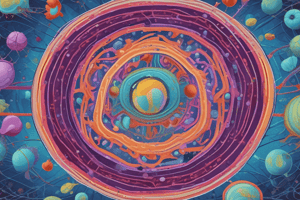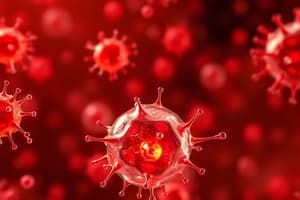Podcast
Questions and Answers
What is the role of p53 protein in the intrinsic apoptosis pathway?
What is the role of p53 protein in the intrinsic apoptosis pathway?
- To induce DNA damage
- To inhibit proapoptotic multidomain family members
- To activate antiapoptotic Bcl2 family members
- To stop the cell cycle and induce repair enzymes in response to lesser DNA damage (correct)
What happens to antiapoptotic Bcl2 family members in apoptotic cells?
What happens to antiapoptotic Bcl2 family members in apoptotic cells?
- They are broken down by the ubiquitin-proteasome system
- They bind to newly synthesized/activated proapoptotic BH3-only family members (correct)
- They bind to proapoptotic multidomain family members to inactivate them
- They are activated and stabilized in response to DNA damage
Which type of cell death is characterized by a regulated process where the cell kills itself for the good of the organism or other cells?
Which type of cell death is characterized by a regulated process where the cell kills itself for the good of the organism or other cells?
- Necrosis
- Mitosis
- Apoptosis (correct)
- Autophagy
What is the term for the shrinkage of the nucleus, followed by chromatin condensation, in apoptotic cells?
What is the term for the shrinkage of the nucleus, followed by chromatin condensation, in apoptotic cells?
What is the result of proapoptotic multidomain family members binding to each other?
What is the result of proapoptotic multidomain family members binding to each other?
What is the function of p53 protein in response to larger DNA damage?
What is the function of p53 protein in response to larger DNA damage?
Which protein family plays a crucial role in regulating the intrinsic apoptosis pathway?
Which protein family plays a crucial role in regulating the intrinsic apoptosis pathway?
What is the role of BH3-only Bcl2 family members?
What is the role of BH3-only Bcl2 family members?
What is the term for the fragmentation of the nucleus in apoptotic cells?
What is the term for the fragmentation of the nucleus in apoptotic cells?
What is the function of p53 protein in response to lesser DNA damage?
What is the function of p53 protein in response to lesser DNA damage?
Which of the following is NOT a characteristic of apoptosis?
Which of the following is NOT a characteristic of apoptosis?
What is the term for the pathway of apoptosis that is initiated by extracellular signals, such as the binding of Fas ligand to Fas receptor?
What is the term for the pathway of apoptosis that is initiated by extracellular signals, such as the binding of Fas ligand to Fas receptor?
What is the role of antiapoptotic Bcl2 family members in healthy cells?
What is the role of antiapoptotic Bcl2 family members in healthy cells?
What is the role of P53 protein in apoptosis?
What is the role of P53 protein in apoptosis?
What happens to p53 protein in healthy cells?
What happens to p53 protein in healthy cells?
What is the role of death ligands in the extrinsic apoptosis pathway?
What is the role of death ligands in the extrinsic apoptosis pathway?
Which of the following is a function of autophagy?
Which of the following is a function of autophagy?
What is the term for the internucleosomal DNA cleavage that occurs in apoptotic cells?
What is the term for the internucleosomal DNA cleavage that occurs in apoptotic cells?
What is the result of p53 protein activation in response to DNA damage?
What is the result of p53 protein activation in response to DNA damage?
Which of the following is a characteristic of necrosis?
Which of the following is a characteristic of necrosis?
Which of the following Bcl2 family members contain only the BH3 domain?
Which of the following Bcl2 family members contain only the BH3 domain?
What is the name of the complex formed by cytochrom C, Apaf1, and procaspase 9?
What is the name of the complex formed by cytochrom C, Apaf1, and procaspase 9?
Which of the following caspases is an initiator caspase?
Which of the following caspases is an initiator caspase?
What is the role of p53 in the intrinsic pathway of apoptosis?
What is the role of p53 in the intrinsic pathway of apoptosis?
What is the result of the release of cytochrom C from the mitochondrial outer membrane?
What is the result of the release of cytochrom C from the mitochondrial outer membrane?
Which of the following is a characteristic of proapoptotic Bcl2 family members?
Which of the following is a characteristic of proapoptotic Bcl2 family members?
What is the name of the protein family that includes caspase 3 and caspase 9?
What is the name of the protein family that includes caspase 3 and caspase 9?
Which of the following is a result of the activation of the intrinsic pathway of apoptosis?
Which of the following is a result of the activation of the intrinsic pathway of apoptosis?
What is the role of the multidomain-proapoptotic Bcl2 family members in the intrinsic pathway of apoptosis?
What is the role of the multidomain-proapoptotic Bcl2 family members in the intrinsic pathway of apoptosis?
Which of the following is NOT a characteristic of caspases?
Which of the following is NOT a characteristic of caspases?
Study Notes
Bcl2 Family
- Proapoptotic family members: BH3-only proteins, synthesized or activated as a result of apoptotic stimuli, bind antiapoptotic Bcl-2 family members
- Examples: Bad, Puma
- Proapoptotic multidomain family members: contain BH1, BH2, BH3 domains, inactivated by antiapoptotic Bcl-2 family members, released and form pores in the outer mitochondrial membrane
- Antiapoptotic Bcl2 family members: contain BH1, BH2, BH3, BH4 domains, always present and active, bind proapoptotic multidomain family members
Caspases
- Important in the effector phase of apoptosis
- Protein family: cysteinyl-aspartases, cleave after an aspartic acid residue
- Present in healthy cells in inactive form: procaspases, activated by cleavage as a result of apoptotic signal transduction
- Active form: cleaves target proteins, very specific cleavage, activates/inactivates them
- Initiator caspases: cleave effector caspases, e.g. caspase 8 and caspase 9
- Effector caspases: cleave many different target proteins, e.g. caspase 3
Intrinsic Pathway
- Activation of p53 induces BH3-only proapoptotic Bcl2 family members
- Released multidomain-proapoptotic family members form pores in mitochondrial outer membrane, releasing cytochrom C to cytosol
- Cytochrom C forms a complex with Apaf1 and procaspase 9, forming an apoptosome
- Procaspase 9 cleaves itself to active caspase 9, cleaving effector caspases
Extrinsic Pathway
- Receptor-mediated apoptosis: death ligands bind to their receptors
Role of p53
- Plays an important role in intrinsic pathway
- Transcription factor, also has functions independent of transcription
- Always synthesized, but broken down in healthy cells
- Activated and stabilized for DNA damage
- Function: stops cell cycle, induces repair enzymes for lesser DNA damage, induces apoptosis for larger DNA damage
Cell Death
- Types of cell death: regulated and not regulated
- Regulated cell death: apoptosis, autophagy, etc.
- Apoptosis: regulated, signal transduction, ATP required, activates under physiological and pathological conditions
- Necrosis: not regulated, pathological circumstances, damaging effect cannot be survived
- Morphological features of apoptosis and necrosis: stimuli, appearance, involved cells, cell nucleus, DNA, cell membrane, organelles, result, inflammation, phagocytosis
Alterations of Nucleus
- Apoptosis: karyopyknosis, karyorrhexis
- Necrosis: karyolysis
Studying That Suits You
Use AI to generate personalized quizzes and flashcards to suit your learning preferences.
Related Documents
Description
This quiz covers the Bcl2 family, specifically the proapoptotic family members, BH3-only proteins, and their role in apoptosis. It also explores how they bind to antiapoptotic Bcl-2 family members.




